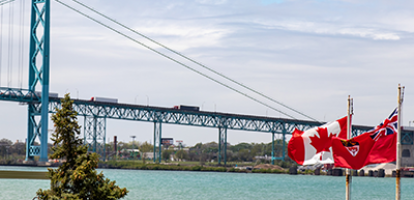From: Jon Johnson
To: Canadians and Americans Fed-up with Section 232 Tariffs
Date: August 13, 2020
Re: Section 232 Aluminum Tariffs – Classic Bait and Switch
With CUSMA in effect for barely a month, the Trump Administration announced that it will re-impose 10-percent tariffs on non-alloyed unwrought aluminum from Canada. The basis is Section 232 of the US Trade Expansion Act of 1962 that permits the president to “adjust” imports of articles that threaten US national security.
The US began imposing 25-percent tariffs on imports of steel and 10-percent tariffs on imports of aluminum from Canada on June 1, 2018. Canada adopted retaliatory measures, and the existence of these tariffs became a major impediment to completing NAFTA renegotiations, a top Trump priority.
On May 17, 2019, Canada and the US issued a Joint Statement announcing the end of these tariffs on steel and aluminum from Canada. This was a welcome development, instrumental in facilitating the conclusion of CUSMA.
There were, of course, pitfalls, and one has materialized. The Joint Statement provided that if imports of aluminum or steel products surge meaningfully beyond historic volumes, the importing party (the US), may request consultations and re-impose tariffs on the products where the surge took place. Imports of non-alloyed unwrought aluminum from Canada into the US over the period June 2019 to May 2020 increased substantially over imports over the previous 12-month period. The Trump administration requested consultations (which took place without any resolution) and has now announced that it will re-impose 10-percent tariffs starting August 16.
The Joint Statement provides that if the importing party (the US) re-imposes tariffs, the exporting country (Canada) “agrees to retaliate only in the affected sector (i.e., aluminum and aluminum-containing products or steel.)” This effectively sanctions retaliation. And as announced last week, Canada will impose a 10 percent surtax on US aluminum and aluminum containing products chosen from a list set out in the Notice starting September 16. (Canada’s list is more expansive than the product categories listed in the Joint Statement for identifying a surge. However, the Joint Statement does not confine retaliation to those product categories.)
So where does this leave us? Before Donald Trump’s decision to re-impose the duties, Canadian non-alloyed unwrought aluminum entered the US duty free. Once the Trump action takes effect, the US importers will be penalized by having to pay a 10-percent duty. Products of the US aluminum industry satisfying CUSMA rules of origin currently enter Canada duty free. Once the surtax is in effect, the US products chosen by Canada will be subject to a 10-percent penalty.
It is difficult to see how anyone benefits from this. While the Canadian aluminum industry will suffer, the US aluminum industry will also be hurt, as will all US consumers of Canadian non-alloyed unwrought aluminum, a widely used product. It is even more difficult to see how any of this has the remotest connection to US national security.
The re-imposition of the Section 232 tariffs is particularly objectionable because in order for passenger vehicles or light or heavy trucks to qualify as originating for CUSMA duty free treatment, 70 percent of the steel and aluminum purchased by the vehicle producer must be originating. The 10-percent tariff on originating Canadian non-alloyed unwrought aluminum, which should enter the US duty free, will discourage US producers from using Canadian product to meet this requirement.
As Inside U.S. Trade reported last Friday, Senate Finance Committee Chairman Chuck Grassley (R-IA) told them that Canadian aluminum imports were not a national security threat. Ron Kind (D-WI) tweeted last Thursday that “President Trump’s announcement today to raise tariffs on Canadian aluminum is extremely disappointing. This is not how we treat allies that we have recently agreed to a new trade deal with.”
These are fine sentiments. However, to date Congress has shown no meaningful inclination to curb the expansive use of Section 232, a hallmark of the Trump Administration. Perhaps after the election, with a new Congress and possibly a new president, Congress may finally take meaningful action to end abuse of Section 232.
Jon Johnson is a former advisor to the Canadian government during NAFTA negotiations and is a Senior Fellow at the C.D. Howe Institute.
To send a comment or leave feedback, email us at blog@cdhowe.org.
The views expressed here are those of the author. The C.D. Howe Institute does not take corporate positions on policy matters.





